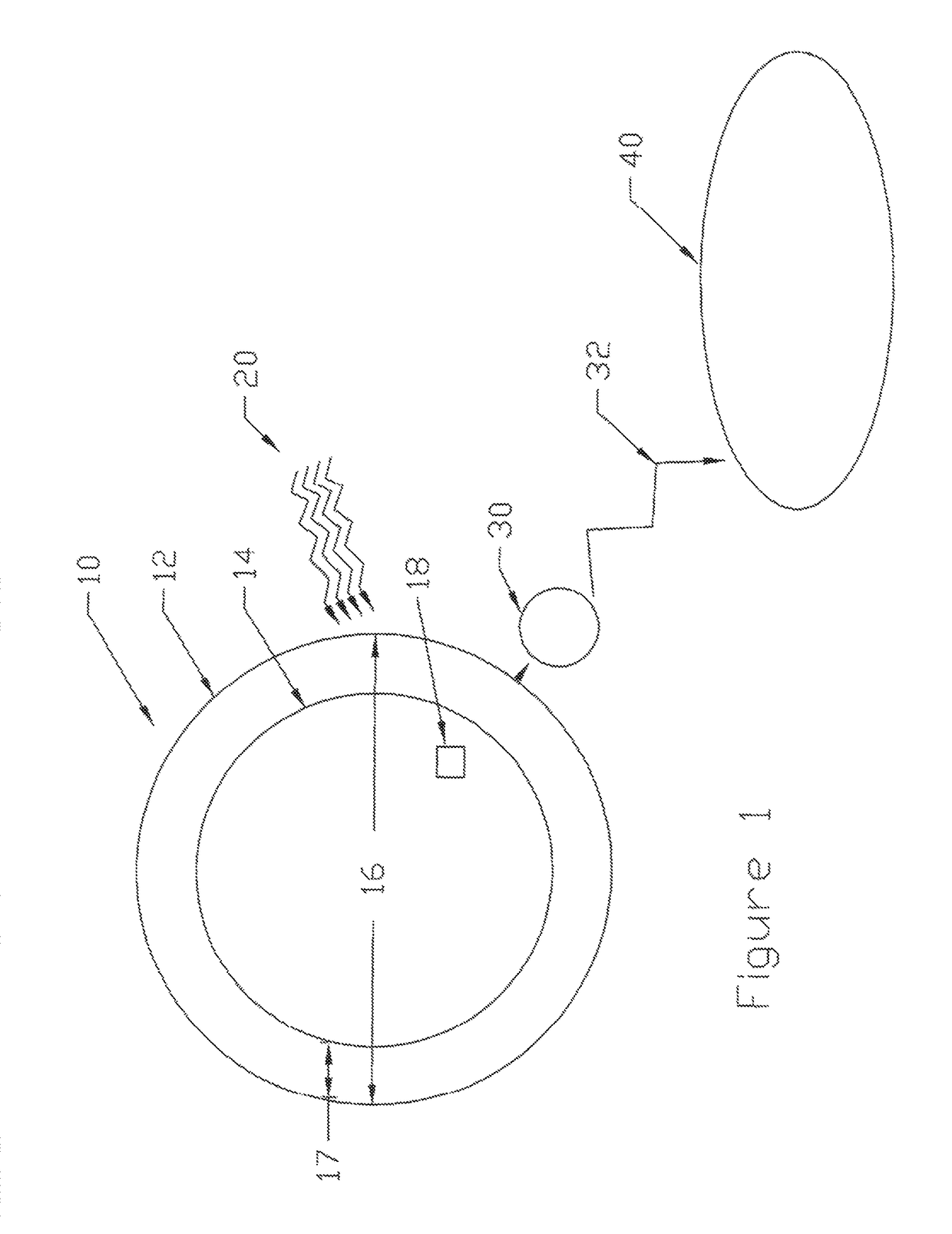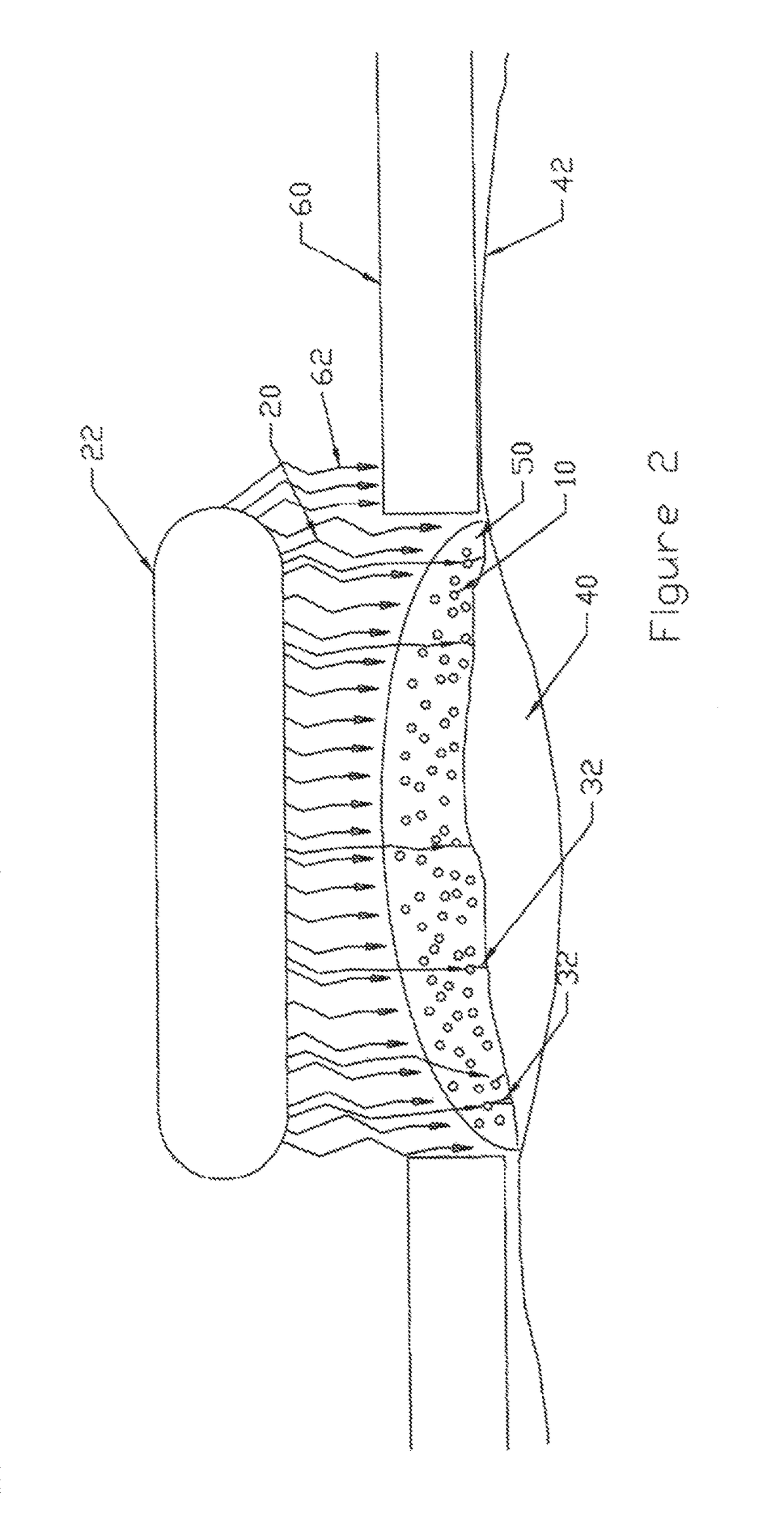As noted by these disclosures, the prior art is very limited in its teaching and utilization, and an improved nanocrystaline based therapy is needed to overcome these limitations.
(a) PDT is a treatment that uses a
drug (chemical), called a
photosensitizer or
photosensitizing agent, and a particular type of light. When photosensitizers are exposed to a specific
wavelength of light, they produce an activated form of
oxygen that kills nearby cells. Each
photosensitizer is activated by light of a specific
wavelength. This
wavelength determines how far the light can travel into the body. Thus, doctors use specific photosensitizers and wavelengths of light to treat different areas of the body with PDT. In the first step of PDT for
cancer treatment, a
photosensitizing agent is injected into the bloodstream. The agent is absorbed by cells all over the body, but stays in cancer cells longer than it does in normal cells. Approximately 24 to 72 hours after injection, when most of the agent has left normal cells but remains in cancer cells, the tumor is exposed to light. The
photosensitizer chemical in the tumor absorbs the light and produces an active form of
oxygen that destroys nearby cancer cells by killing them (
necrosis) rather than by the natural
cell death mechanism (
apoptosis). In addition to directly killing cancer cells, PDT appears to shrink or destroy tumors in two other ways. The photosensitizer can damage blood vessels in the tumor, thereby preventing the cancer from receiving necessary nutrients. In addition, PDT may activate the
immune system to
attack the
tumor cells.
(b) The light used for PDT can come from a
laser or other sources of light.
Laser light can be directed through
fiber optic cables (thin fibers that transmit light) to deliver light to areas inside the body. For example,
fiber optic cable can be inserted through an
endoscope (a thin, lighted tube used to look at tissues inside the body) into the lungs or
esophagus to treat cancer in these organs. Other light sources include light-emitting diodes (LEDs), which may be used for surface tumors, such as
skin cancer. PDT is usually performed as an
outpatient procedure. PDT may also be repeated and may be used with other therapies, such as
surgery,
radiation, or
chemotherapy.
(c) To date, the U.S.
Food and Drug Administration (FDA) has approved the
photosensitizing agent called porfimer
sodium, or PHOTOFRIN®, for use in PDT to treat or relieve the symptoms of
esophageal cancer and non-
small cell lung cancer. Porfimer
sodium is approved to relieve symptoms of
esophageal cancer when the cancer obstructs the
esophagus or when the cancer cannot be satisfactorily treated with
laser therapy alone. Porfimer
sodium is used to treat non-
small cell lung cancer in patients for whom the usual treatments are not appropriate, and to relieve symptoms in patients with non-
small cell lung cancer that obstructs the airways. In 2003, the FDA approved porfimer sodium for the treatment of precancerous lesions in patients with Barrett's
esophagus (a condition that can lead to
esophageal cancer). Porfimer sodium makes the
skin and eyes sensitive to light for approximately 6 weeks
after treatment. Thus, patients are advised to avoid direct
sunlight and bright indoor light for at least 6 weeks. Photosensitizers tend to build up in tumors and the activating light is focused on the tumor. As a result, damage to
healthy tissue is minimal. However, PDT can cause burns, swelling, pain, and scarring in nearby
healthy tissue. Other side effects of PDT are related to the area that is treated. They can include coughing, trouble
swallowing,
stomach pain, painful
breathing, or shortness of breath; these side effects are usually temporary.
(d) The light needed to activate most photosensitizers cannot pass through more than about one-third of an inch of tissue (1
centimeter). For this reason, PDT is usually used to treat tumors on or just under the
skin or on the lining of internal organs or cavities. PDT is also less effective in treating large tumors, because the light cannot pass far into these tumors. PDT is a local treatment and generally cannot be used to treat cancer that has spread (metastasized).
(e) Researchers continue to study ways to improve the effectiveness of PDT and expand it to other cancers. Clinical trials (research studies) are under way to evaluate the use of PDT for cancers of the brain, skin,
prostate,
cervix, and
peritoneal cavity (the space in the
abdomen that contains the intestines, stomachs and liver). Other research is focused on the development of photosensitizers that are more powerful, more specifically target cancer cells, and are activated by light that can penetrate tissue and treat deep or large tumors. Researchers are also investigating ways to improve equipment and the delivery of the activating light.
As noted by this basic information, several problems exist with current photosensibilizers due to patient sensitivity increases for up to 6 week periods, overexposure of the patient to the photosensibilizers, the expense and difficulty associated with this class of photosensibilizers, and most importantly the difficulty of precise delivery of the
singlet oxygen to specific
tumor cells by having to “
shoot beams of light” onto targets of photosensitizing agents administered by
system injection to all
body cells.
Excessive
apoptosis causes hypotrophy, such as in ischemic damage, whereas an insufficient amount results in uncontrolled
cell proliferation, such as cancer.
Interaction with solvents, however, reduces the lifetime to
microsecond or even nanoseconds.
However, the device is not intended for generating singlet oxygen, but for so-called “softer activation of the oxygen”.
The design of the device is extremely complicated.
The known devices which have been employed for production of singlet oxygen have been large and cumbersome and / or complicated or it has not been possible to document that the production of singlet oxygen has actually taken place.
With all of this information in mind, it may be seen that these prior art teachings, publications, and patents are very limited in their teaching and utilization, and an improved
silicon nanoparticle and method of use is needed to overcome these limitations.
 Login to View More
Login to View More  Login to View More
Login to View More 

